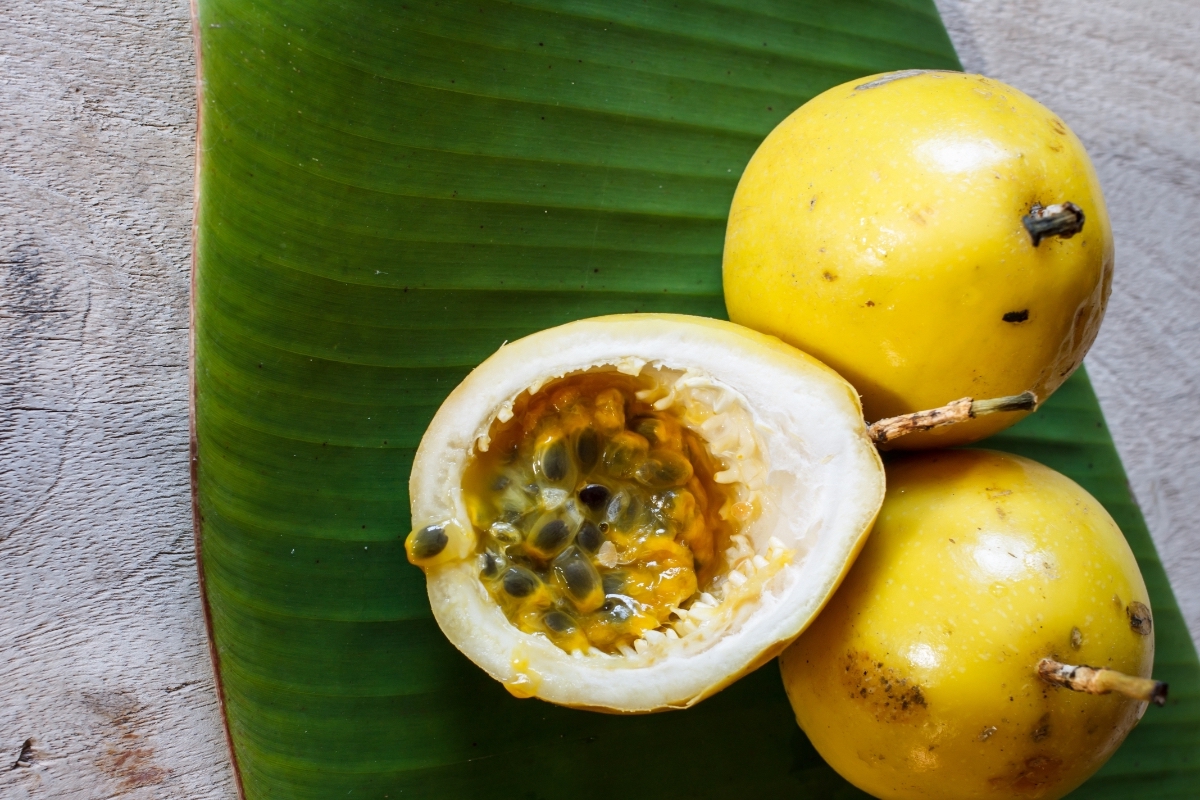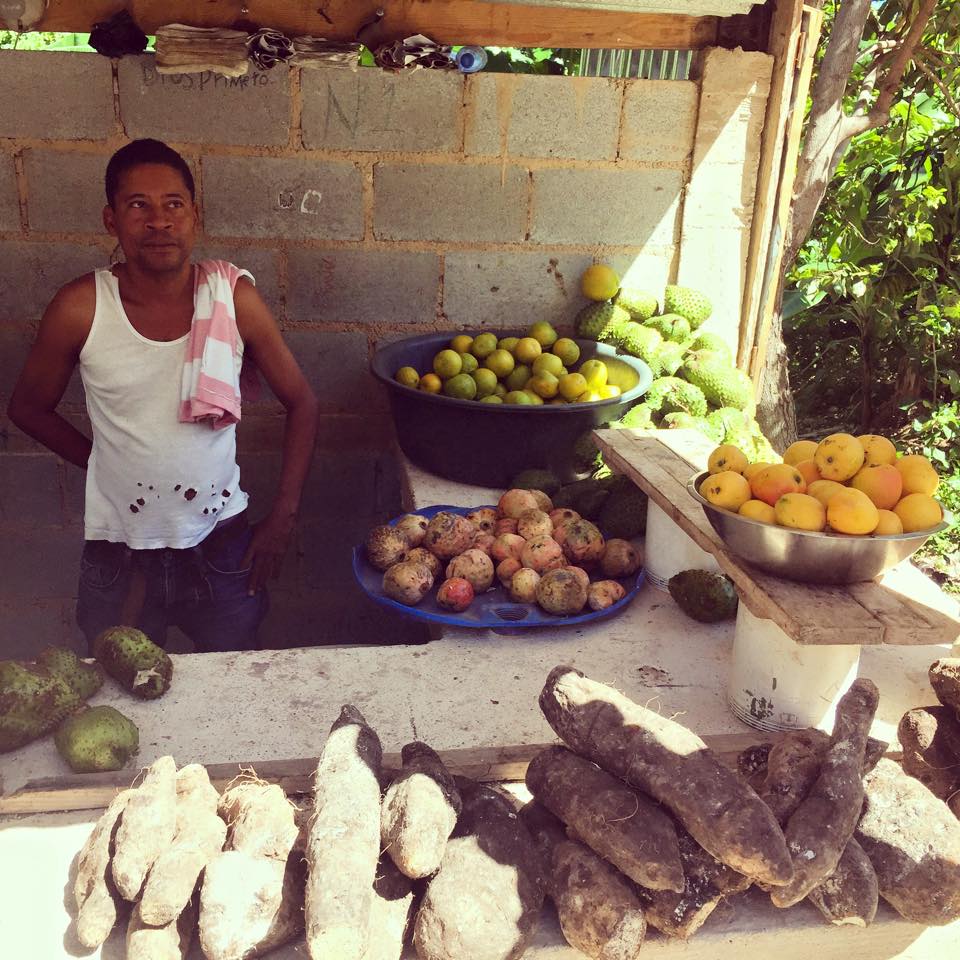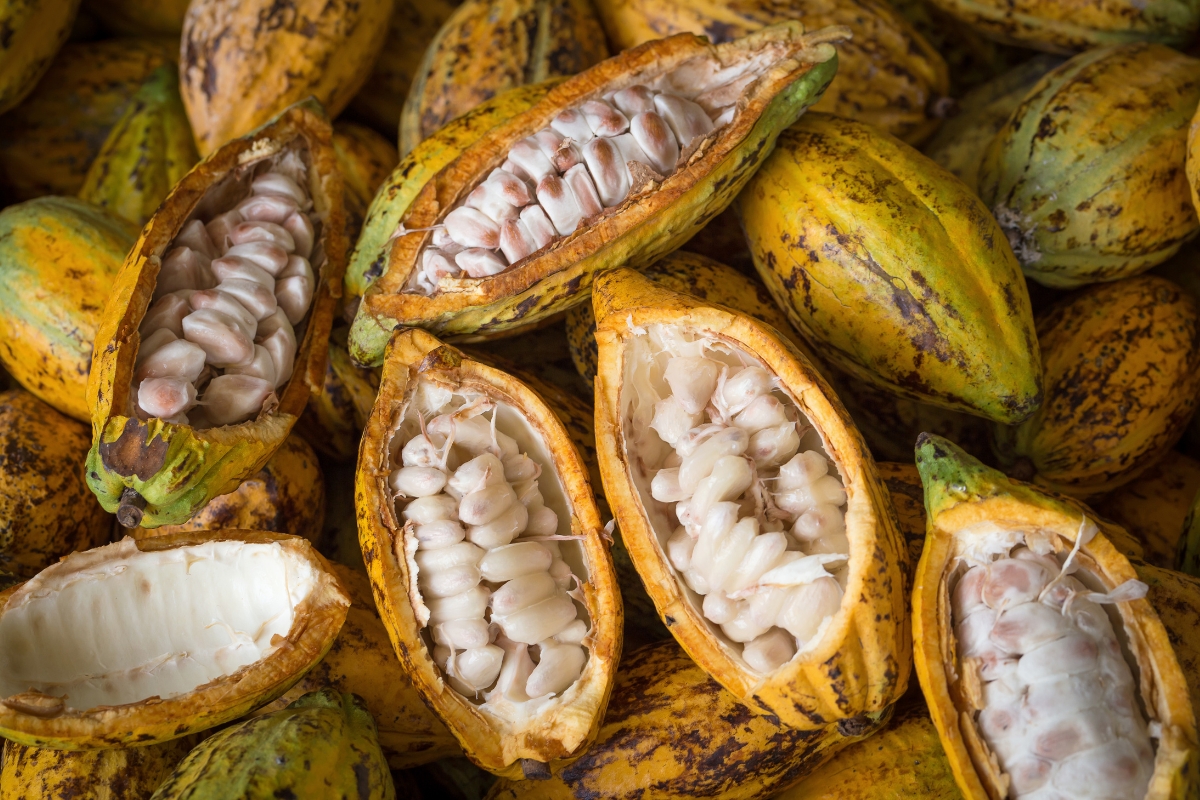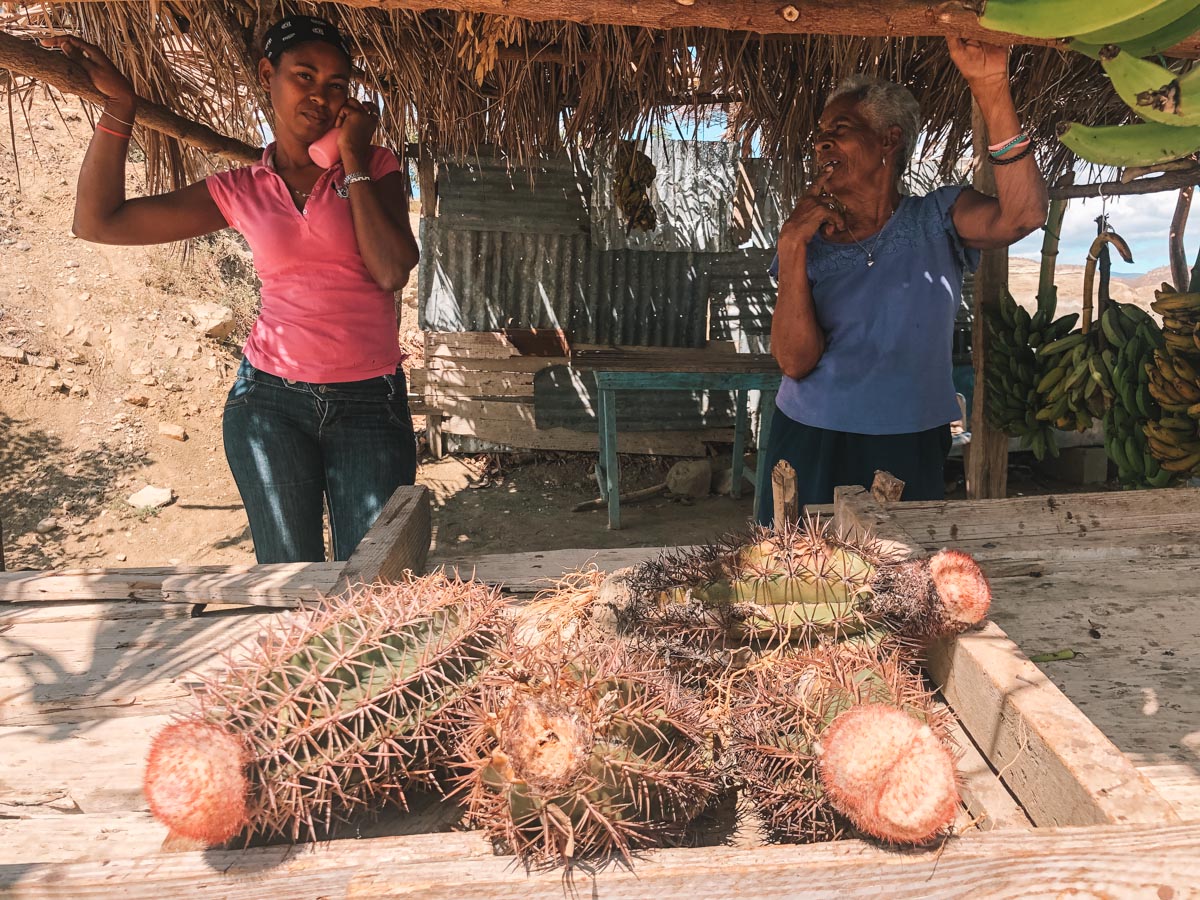Culture, Dominican Republic, Food
23 Uniquely Cool Dominican Fruits to Try
From the common fruits, like mango, to the seasonal ones you can only find on the coasts, the Dominican Republic offers an abundance of delicious and nutritious fruits. With a diverse geography that includes rainforests, coastal regions and mountains, the land is fertile and produces Dominican fruits year round.
There’s plenty to explore in the Dominican Republic and fortunately this diversity of fruits means that any trip can be enjoyed with fresh fruits. We’ve put together a list of tropical fruits of the Dominican Republic, from the most popular to the rare finds–fruitarians rejoice!
Please note: Some of these Dominican Republic fruits are native to the Americas and others came from abroad and are now a traditional staple. We indicated below which Dominican fruit is native to our island/the Americas!
Table of Contents
THE COOLEST Dominican Fruits to Try
1. Chinola (Passion Fruit)


Native to the Dominican Republic, chinola is a local favorite for juices and cocktails. This citrus fruit has a sweet aroma, yet is actually really sour alone and thus is often sweetened with sugar or honey. Varieties come in yellow and purple, with a tough outer skin and seed-filled pulp inside.
Passion fruit is a great source of vitamin c, vitamin a, antioxidants, and even iron. The pulp and beautiful flower are used to make tea and remedies for the common cold. It is also a popular ingredient in dessert recipes.
Pro tip: the skin becomes wrinkled when it is ripe!
- Native to the Dominican Republic
2. Jagua

Jagua, a fruit native to the island and the Americas, is still consumed the way our Taino ancestors taught us. Small but potent, this fruit oval light brown fruit is used to make a popular fermented drink, medicinal teas, and natural ink. Our Taino ancestors would use the ink to paint their bodies in ceremonies and to protect their skin from insects, among other uses. Like henna, it can be used as a natural temporary dye that is safe for the skin and can also be used to treat rashes and skin conditions.
Pro tip: Cut up some jagua fruit, add it to a pot with water and add passionfruit pulp for a delicious drink. Or heat it up for tea, but just note that when you boil fruits you may lose some of the naturally occurring nutrients.
- Native to the Americas
3. Guayaba

Native to the Dominican Republic (and Central America), guava or guayaba is considered a sacred fruit to these lands. From our Taino ancestors to modern-day life, the guava fruit is immensely popular, nutritious and, medicinal. The most common type even grows wild in forest areas, and is small to medium sized with yellow skin and pink pulp with many small seeds.
Guava is one of the Dominican fruits with some of the highest content of vitamin c and is low in calories but high in fiber. The fruit is common in juices, jams or dulces (Dominican sweets), and its leaves are used for medicinal teas to treat cold symptoms.
If you can get your hands on an empanada with guava jam with cheese inside, please do!
- Native to the Americas
4. Lechoza (Papaya)

Papaya, locally known as lechoza, is a Dominican favorite and is found easily throughout the country. A cold papaya smoothie is both filling and nutritional because the fruit contains antioxidants that can reduce inflammation and maintain heart health. Dominicans traditionally use the fruit to treat constipation and the seeds to treat diarrhea, parasites, and/or food poisoning.
It can be tricky to pick the perfect ripe papaya, so if you ever find yourself with one that is under-ripe, squeeze lime juice on it and refrigerate it before consumption.
- Native to the Americas
5. Guanabana (Soursop)



Another tropical fruit native to the Dominican Republic (and the Americas) is Soursop, locally known as guanabana. This is a seasonal fruit and not always available, so if you happen to find any, treat yourself. Soursop juice is one of the most refreshing out there and offers many benefits because it is high in antioxidants and antibacterial properties. Studies show it may help reduce cancer cells and reduce inflammation. Homemade soursop ice cream is popular in the country, and like other Dominican fruits, the leaves are used to make tea.
- Native to the Americas
6. Mamey
Mamey, not to be confused with Zapote, is native to the Caribbean islands and is in my humble opinion at risk of extinction. My grandparents consumed it but it is rarely found in markets and the general knowledge of this ancestral fruit seems to be getting lost. Scientific name, Mammea Americana, it has a brown rind and inside the fruit is a yellow-orange color. The flesh is hard when unripe and softens when ripe and ready to eat.
- Native to the Americas
7. Zapote

Locally this fruit is known as Zapote, although in other countries and in English it appears to be called Mamey Sapote. Zapote as we know it is commonly served as a delicious smoothie or the fruit is eaten raw. It’s a small fruit, generally found in supermarkets, with a brown skin and dark orange flesh with a large seed. This Dominican fruit is loaded with fiber, vitamin b6 and copper which can help against anemia and improve immunity.
Fun fact: This fruit is known as mamey in Cuba! Oop.
- Native to the Americas
8. Mango




Arguably the world’s favorite fruit, mangos can be found year-round in the Dominican Republic, but it can be a real delight during the summer months when mango season hits its peak. The southern city of Bani, known as the Capital of Mangos in the country, hosts an annual Mango Festival during the month of June. With hundreds of varieties and all kinds of goods derived from Dominican mango, the Festival offers a feast for fruit lovers and a practical lesson into the importance of supporting local producers.
Bani is also known for having their own special type of mangos called mangos banilejos. So be sure to stop for some of these mangos on your next road trip through Southwest Dominican Republic.
Originating from India, Mangos are incredibly sweet and offer many health benefits due to high vitamin c and antioxidant content. It’s common to find them in backyards and even town streets where Dominicans collect and share fresh fruit harvests with neighbors.
9. Cereza (Acerola Cherry)


Cereza juice is a Dominican treat like few others and many of us have fond childhood memories of picking ripe acerola cherries and making homemade dulce de cereza (a Dominican jam that utilizes the whole fruit). Acerola cherry is extremely potent, it has been found to have more vitamin c than oranges and strawberries but the downfall is that it is very perishable so should be consumed or frozen within five days of picking. Although technically not actually a cherry, Cerezas are a mix of sweet and sour with a smaller size and deep red color.
- Native to the Americas
10. Pineapple

Probably the most iconic tropical fruit originating in the Americas, the pineapple has a fascinating history in the Dominican Republic, where it was once the hub for production and exportation and the most valuable fruit in Europe. It is now widely considered a symbol of hospitality and of course tropical aesthetics.
Pineapple is incredibly healthy, with a variety of nutrients like vitamin c, manganese and vitamin b6. An unsweetened pineapple juice aids in digestion and is refreshing on those sweaty hot days on the island. In the Dominican Republic you will find lots of ways to consume pineapple, in juices, cocktails, jams and desserts to name a few. We also use the skin for tea! Yum.
If you’ve only had imported pineapples, you will see heaven once you try a fresh and sweet piña grown locally.
- Native to the Americas
11. Mamon
The next two fruits on our list are very similar, in the same family of soursop, and are native to the island. Mamon is a type of custard apple that can be eaten raw, not to be confused with the popular red custard apple, ours has an orange-yellowish color with the shape of a heart. Like soursop, it has a white flesh with many seeds that can be scooped out. Although extremely common and found in most backyards, Mamon is not generally sold in local markets.
12. Anon

Similar to Mamon and Guanabana, Anon has a sweet white flesh with seeds yet it is smaller in size and has a skin similar to scales. In English it may be called a sugar apple and in other countries, Cherimoya. It is rich in fiber, magnesium and certain antioxidants that promote eye health and can regulate blood pressure. I’ve found this fruit in street markets in the south of the Dominican Republic, by Bani during the early fall months but it is not as common.
13. Naranja agria (Bitter orange)


Although not native to the region, Bitter Orange or Sour Oranges have become a staple in Dominican cuisine. Like the name implies these varieties of oranges are extremely sour and tart-like, and the raw pure juice is traditionally used to clean and marinade meat such as chicken and goat prior to cooking. This fruit is also locally used to make remedies for the common cold. The juice is sweetened with honey or sugar and is quite refreshing even with some of the sour taste. Orange varieties in the Dominican Republic are not the picture-perfect orange from Florida that we are used to in marketing, they are often a deep green color on the outside and sometimes become slightly yellow.
14. Tamarind

Native to Africa, Tamarind is a beautiful tree that produces incredible shade and a delicious sweet and sour fruit with many benefits. The fruit comes in a bean-like pod, with pulp and seeds inside that when ripe are a deep brown color. It is often sold in supermarkets just as a pulp in small bags but can be found in markets as the whole fruit. Dominicans believe that tamarind juice can aid with sleep problems and often give it to children after dinner as a routine to guide a good night’s sleep.
Tamarind is nutritious with high amounts of magnesium, potassium, iron and the coveted antioxidants, amongst others. When ordering a tamarind juice we recommend that you ask for it sugar free because even though it has a tart and sour texture, tamarind is high on natural sugars.
15. Pitahaya (Dragon fruit)

Pitahaya or Dragon Fruit is growing in popularity in the Dominican Republic, even though it is native to the region. Varieties of this cactus actually grow wild in the forests of the country but unfortunately historians suspect that its usage was lost to the population during colonization because Spanish colonizers used warfare tactics such as burning of crops and forests to oppress indigenous populations.
In recent years, there has been an agricultural push to grow this fruit for exportation which has also made it readily available during the early months of summer. With a magenta skin, resembling dragon scales, the different varieties have either a magenta, white or yellow pulp. It’s high in fiber, antioxidants and prebiotics which promote a healthy gut. This Dominican fruit is a common remedy for constipation as well.
- Native to the Americas
16. Cacao (Where Chocolate Comes From)


Cacao or fruit of the gods, is native to the continent of the Americas and considered a sacred fruit and plant by indigenous populations. Cacao is one of the most valuable fruits of the Dominican Republic. The pod of the cacao plant, through processing of the seeds becomes cocoa powder, cocoa butter and chocolate. While there are many farms dedicated to the cacao plant for the creation of chocolate products, it is also common for families to grow their own but it is not common to find the raw fruit pod in markets. If you do get your hands on one, the white pulp that surrounds the seed when ripe is edible and can be used to make a refreshing drink. Generally the seeds are dried and fermented before being transformed into the chocolate products we know.
- Native to the Americas
17. Carambola (Star fruit)

Carambola or star fruit is native to Southeast Asia but is cultivated in the caribbean and has become an iconic Dominican fruit. It is a sweet and sour fruit that resembles a star when cut into slices. In the country, it is generally juiced or made into a jam that is delicious on fresh baked bread or pancakes. Low in calories, Carambola has high amounts of antioxidants but it can be dangerous for anyone with kidney problems due to its high oxalate content. Most varieties can be very sour but work really well added to salads or fresh juices.
18. Hicaco (Icaco)

Hicaco/Icaco (scientific name Chrysobalanus icaco) is a unique fruit that grows on the beaches of the island. I personally came to know this fruit because it is found in abundance all along the north coast where children and families often collect it to make jams. The varieties I have seen are small, fitting in the palm of your hand and of white-greenish flesh. It has a light sweet flavor and can have tart when underripe. This fruit is not found in markets, you’ll have to forage the beaches for this rare find.
19. Uva de Playa (Sea Grape)
Another unique fruit that is found along the north coast of the country is the sea grape, locally uva de playa. During the late summer and fall months, children often head to the beach to collect these deep purple clusters. Sometimes sea grapes are sold by the bucket in the city of Puerto Plata, becoming a must try of things to do in Puerto Plata. It is a delight to watch the sunset and collect these fruits, which can be used to make juice or jam. Like normal grapes, sea grapes are high in antioxidants and can be used to make a similar liquor to wine.
- Native to the Americas
20. Cajuil Soliman (Rose Apple)

Cajuil Soliman, manzana de agua or rose apples is one of those fruits that everyone has in their backyard, yet are not found in markets for sale. If you happen to be in the country around the months of April and May, then you will find an abundance of this pink/red apple and most likely will be handed a bucket or two. They have a fragrant flavor resembling roses and a high water content making it refreshing. Rose apples are also high in calcium and potassium. This is a fruit that is often ignored but it makes a naturally sweet juice and can be used to make a homemade apple sauce that is a soft pink color.
21. Memiso

The Memiso, in English the Jamaica Cherry, is a forgotten fruit with a rich history. Consumed by our Taino ancestors, it is a small fruit with tiny seeds which like all ignored fruits are often picked at by children where it grows wild. Light yellow or red skin, it is soft when ripe and can be used to make a jam. This Dominican fruit can grow in some of the worst conditions which explains why it has survived all of the changes in the island.
Fun fact: The Battle of Memiso, an important battle in the fight for Dominican independence took place in El Memiso, a region of Azua named after this ancestral fruit.
- Native to the Americas
22. Coconut

The Caribbean landscape would not have the same inviting and warm atmosphere without the palm trees that cover the islands. The coconut palm tree is both majestic in sight and versatile in its use. Throughout the country you will find various ways to try the delicious coconut fruit; coconut water is often sold at sidewalks or colmados (mom and pop grocery stores) where a skilled person will open its tough shell with a sharp machete.
Pro tip: Young coconuts have the sweetest water and the raw white meat inside is softer and refreshing. Coconut water is a must on those hot days and the products derived from coconut, like milk, cream and oil, are used in many traditional Dominican dishes. Moro de guandules con coco is one of the most iconic Dominican foods to try that uses coconut. Coconut also has many health benefits with a variety of minerals such as magnesium, iron and potassium, while being low in carb and high in fiber.
23. Limoncillo

Limoncillos elicit strong emotional responses throughout the Caribbean, you either love it or hate it. Also known as kenepas or mamoncillos, these seasonal summer fruits are usually sold on the side of highways or beach walks. They are small with a thin green shell and an interior pink pulp that can be bittersweet and with a large seed. It’s usually a snack that kids enjoy; you snap the shell and suck on the pulp while discarding the seed. Believed to be originally from South America, limoncillos grow throughout the region and are believed to be high in iron.
- Native to the Americas
Safety: Eating fruits in the Dominican Republic
The Dominican Republic has much to offer for fruitarians and enthusiasts alike. When shopping for a fruit that is unknown to you, don’t be afraid to ask the vendor for assistance to select the ripe fruits or to ask for tips on how to best prepare it. Vendors are usually friendly and love to share their knowledge.
It is important that you properly clean your fruits before consuming them, especially fruits with edible thin skin like Cerezas, Uva de playa and Memiso. Traditionally, Dominicans like to prepare a water soak with a drop of bleach. I prefer a tablespoon of vinegar but you do you. Soak for a few minutes, make sure to remove any dirt and dry before enjoying.
Did we miss any tropical fruit found in the Dominican Republic? Tell us in the comments below.
Other Unique Fruits of the Dominican Republic



Other fruits native to the Dominican Republic:
- Grena de pina: used to help with a certain type of kidney stone (but can worsen other types of kidney stones).
- Vija: used as an herb for seasoning food, sunscreen, and medicinally for menstrual health
- Higuero: used for hair masks and to make cups!
- Manzanza de oro: a fruit that tastes like a pear and a mango
- Atun: basically the sister of dragonfruit but smaller with thorns. Bright red on the insane, kind of salty, and tastes like nothing! You can find this in Laguna de Oviedo.
- Avocados: Not a unique fruit, but fun fact that they’re native to the Americas!
More Dominican Republic Blog Posts
- Most Iconic Dominican Dishes to Try
- Understanding Dominican Culture Today
- Best Places to Visit in the Dominican Republic
- Coolest Hikes in the Dominican Republic
About the Author: Moraima Capellan
Moraima Capellán Pichardo is a Dominican-born, writer, visual creator, organizer, and yoga teacher. After living in Brooklyn, New York, Moraima returned home and is based in Cabarete, Dominican Republic. She has written for Oprah Daily, The Huffington Post, La Galeria Magazine, and Healthista, among others. Most recently, Moraima co-founded and is the Executive Director of Cabarete Sostenible. Find her work at moraimacp.com, or on social media at @moraima_cp.


